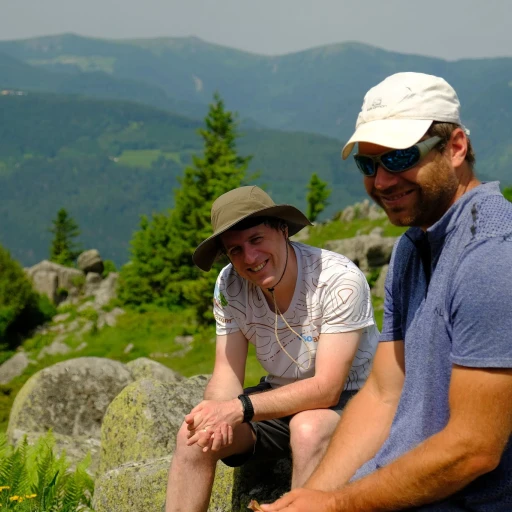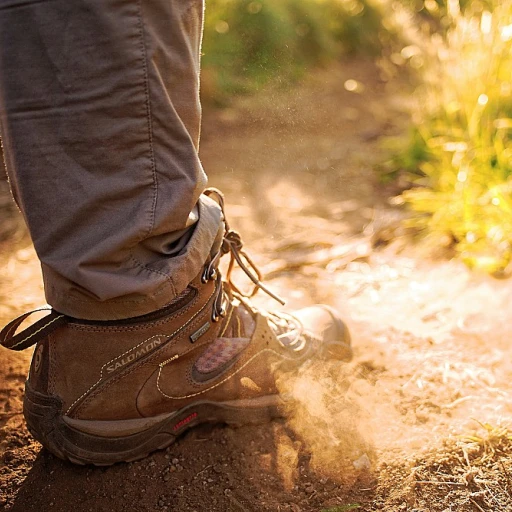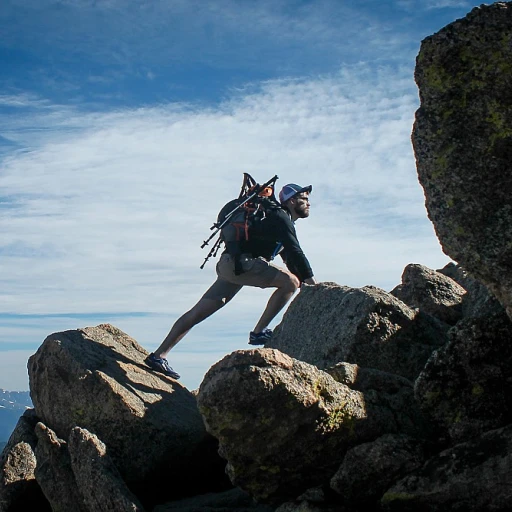
Wicklow Mountains: A hiker's paradise
Wicklow mountains have trails for everyone
The Wicklow Mountains are a must-do for anyone who loves the outdoors. This area is often celebrated as a hiker's paradise. Whether you're a seasoned trekker or a casual stroller, there's something for you here. The Wicklow Mountains National Park is Ireland's largest national park and is home to a variety of trails that cater to all levels.
One popular route is the Glendalough hike, offering stunning views of the ancient monastic city and its surrounding lakes. Glendalough means 'Valley of the Two Lakes,' and the scenery here does not disappoint. According to the National Parks and Wildlife Service, over 1 million visitors explore Glendalough each year, drawn by its historical ruins and lush landscapes.
If you’re looking for a more challenging experience, try the Spinc and Wicklow Way trail. It winds through the heart of the Wicklow Mountains and is perfect for those looking to test their endurance. The Spinc Ridge offers panoramic views that make the effort worthwhile. Local guide John O’Meara says, “Watching the sunrise from Spinc Ridge makes an early start entirely worthwhile.”
The Wicklow Way is another highlight, spanning 127 kilometers from Marlay Park in Dublin to Clonegal in County Carlow. It’s Ireland’s oldest waymarked hiking trail, and sections of it can be tackled in a single day or over a longer multi-day hike. A 2014 study by Mountaineering Ireland highlighted that more than 15,000 hikers take on the Wicklow Way each year, showcasing its enduring popularity.
The Wicklow Mountains are also littered with hidden gems like the Bog Frogs Loop and Queen Maeve Trail. These lesser-known routes offer solitude and tranquility, far from the crowded paths. The trails are well-maintained, and there's ample parking at popular starting points like Glendalough car park and Crone Woods car park.
Don’t forget the wildlife – deer, foxes, and various bird species call this park home. Nature enthusiasts will find plenty to appreciate beyond the breathtaking views. Overall, the Wicklow Mountains encapsulate the spirit of hiking in Ireland.
Looking to explore more stunning hikes in Ireland? Stay tuned as we delve into the breathtaking Cliffs of Moher and coastal marvels of the Dingle Peninsula.
Cliffs of Moher: Coastal walks with breathtaking views
Cliffs of moher breathtaking experience
Located in County Clare, the Cliffs of Moher are one of Ireland’s most iconic natural attractions. Stretching for about 14 kilometers along the Atlantic coast, these cliffs offer some of the most stunning views you'll ever see. Rising up to 214 meters at their highest point, they present a dramatic edge between land and sea.
According to the Cliffs of Moher Visitor Experience, over 1.5 million people visit every year to marvel at these awe-inspiring rock formations. You might even spot the puffins that nest in the cliffs during the summer months!
There are several hiking trails at the Cliffs of Moher, but the most popular one is the official Cliffs of Moher Coastal Walk. This trail extends for about 20 kilometers from Liscannor in the south to Doolin in the north. The walk generally takes around 4 to 5 hours to complete, depending on your pace and how often you stop to soak in the views.
Key stats:
- Elevation: Up to 214 meters
- Trail length: Approximately 20 kilometers
- Time to complete: 4 to 5 hours
One particularly stunning viewpoint is O'Brien's Tower, built in 1835 by Cornelius O'Brien to impress his guests. For a small fee, you can climb to the top of the tower for even more panoramic views.
Do take note though, the weather can be unpredictable, so it’s always a good idea to bring a rain jacket and wear sturdy hiking boots. Speaking from personal experience, the winds can be fierce, making the cliffs even more dramatic yet potentially perilous. Safety first!
For more information on spectacular hikes, make sure to check out our guide on the top 10 hikes in Utah.
The Kerry Way: An introduction to multi-day hikes
Mult-day adventure
The Kerry Way is a 214-kilometer loop that offers a stunning introduction to multi-day hikes in ireland. Starting and ending in Killarney, this trail takes hikers through some of the most picturesque landscapes in County Kerry. The scenery varies from lush woodlands and mountains to tranquil lakes and valleys, providing an unforgettable experience for both seasoned trekkers and beginners.
According to expert Eric Jones, a renowned mountaineer and adventurer, 'The Kerry Way is one of the best ways to experience the true beauty of ireland.' It's not just about the physical challenge; it's also an opportunity to connect deeply with nature and the local culture.
What to expect on the trail
The Kerry Way can be completed in 8-10 days, depending on your pace and the amount of time you want to spend in each section. Most hikers break the route into manageable day hikes, with ample opportunities for rest and resupply in towns like Glenbeigh, Waterville, and Sneem.
Trail conditions are generally good, with well-marked paths and plenty of signposts. However, parts of the trail can be boggy, so having a sturdy pair of hiking boots is essential. For tips on choosing the right gear, you might find this guide to the top 10 hikes in Washington helpful.
Highlights along the way
- Lough Leane: The trail begins with stunning views of Lough Leane in Killarney National Park, the largest of Killarney’s three lakes.
- Gap of Dunloe: This iconic glacial valley is a must-see, offering dramatic scenery and a sense of isolation.
- Black Valley: This secluded and quiet area is often cited as one of the most beautiful parts of the trail.
- Coastal views: As you approach the Atlantic coast, you'll be treated to breathtaking views of the ocean and rugged cliffs.
Practical information
While the Kerry Way is generally safe, it's always best to be prepared. Make sure to carry a detailed map, sufficient food and water, and emergency supplies. Weather conditions in ireland can change rapidly, so layers and waterproof gear are recommended.
If you’re planning to embark on a hike in the Wicklow Mountains or explore the Cliffs of Moher, you’ll find that the diverse terrains of the Kerry Way provide an equally rewarding experience. Whether you’re drawn to the spiritual journey of Croagh Patrick or the unique landscapes of Burren National Park, each hike offers its own set of challenges and stunning views.
Croagh Patrick: Ireland’s holy mountain
The spiritual ascent of croagh patrick
Known as Ireland’s holy mountain, Croagh Patrick boasts a striking mix of natural beauty and religious significance. With an elevation of 764 meters, this iconic peak located in County Mayo is where generations of pilgrims have ascended to honor St. Patrick. Embarking on this hike is not just a physical challenge, but a spiritual journey that attracts devout Catholics from around the globe.
The most popular route begins from the car park in the village of Murrisk, near the beautiful Clew Bay. The climb typically takes around 2 to 4 hours, depending on your pace and weather conditions. Be prepared for a strenuous journey, particularly in the final section where the trail becomes steep and rocky. Proper hiking boots are essential for this adventure. According to a study by Mayo County Council, around 100,000 people undertake this pilgrimage each year, with a significant spike during Reek Sunday, the last Sunday in July when tens of thousands make the ascent.
Historical and cultural significance
This mountain is not just a hiking challenge, but also steeped in history. Legend has it that St. Patrick fasted for 40 days and nights on the summit in 441 AD, banishing snakes from Ireland in the process. The mountain is dotted with historical sites, including a modern chapel at the peak, built in 1905. Exploring these sites offers a deeper connection to Ireland's past and its cultural heritage.
Beyond its spiritual significance, the views from the summit are simply breathtaking, providing a panoramic vista of Clew Bay’s 365 islands and the surrounding Connemara mountains. If you're lucky with the weather, which can be unpredictable, you’ll get a reward that’s nothing short of majestic.
Expert insights and tips
According to mountaineer and trail expert Paul O’Sullivan, “Croagh Patrick is one of those climbs that tests your mettle but also rewards you with a sense of accomplishment and spiritual fulfillment.” He advises hikers to start early in the day to avoid evening fog and to bring adequate water and snacks. “Weather can change rapidly, so layered clothing and a waterproof jacket are must-haves,” he adds.
Case studies: unforgettable pilgrimages
Many hikers share their transformational stories after completing the climb. One such tale is of Maria Horgan, who climbed Croagh Patrick annually for over two decades despite battling arthritis. “It’s not just about reaching the top,” she says, “it’s about the faith and community that you feel every step of the way.” Another account is from John Barrett, who hiked to raise funds for charitable causes, making the experience even more fulfilling.
While every part of Ireland offers unique hiking trails, Croagh Patrick stands out for its blend of physical challenge, historical depth, and spiritual intrigue. This hike is not just an outdoor activity; it's an experience steeped in the essence of Irish heritage and resilience.
Mourne Mountains: The highest peaks in Northern Ireland
The appeal of the Mourne Mountains
When it comes to the highest peaks in Northern Ireland, the Mourne Mountains stand tall and proud. Located in County Down, these majestic highlands are a favorite among adventurers and nature lovers alike.
The highest point here is Slieve Donard, which soars at 850 meters (2,789 feet). But don't let the height intimidate you! The well-marked trails and the rewarding views make the climb worthwhile. According to Sport NI, about 15% of Northern Ireland's population have hiked these mountains.
Climbing Slieve Donard
Slieve Donard offers a challenging yet doable hike, attracting thousands of hikers annually. The walk starts at Donard Car Park in Newcastle and follows the Glen River. A steep climb, sure, but the panoramic views of Newcastle and the Irish Sea are worth every drop of sweat. It typically takes six hours to complete, making it a fantastic day hike.
Exploring other peaks
The Mourne Mountains aren't just about Slieve Donard. Another must-see is Slieve Bearnagh, known for its iconic rocky tors. Its rugged beauty has even inspired C.S. Lewis, who referenced the Mourne Mountains as an inspiration for Narnia. Slieve Binnian and Slieve Commedagh also offer demanding but rewarding treks, perfect for those looking to explore diverse terrains.
Safety and preparation
Safety is key when tackling these peaks. The National Trust recommends always checking the weather before heading out, as conditions can change rapidly. Good hiking boots and waterproof gear are essential, given the unpredictable Irish weather. Don't forget to pack plenty of water and snacks for energy.
Community and conservation efforts
The Mourne Heritage Trust is heavily invested in maintaining these trails, ensuring they remain accessible and safe for all hikers. Their efforts include repairing paths and educating visitors about conservation, making sure that the natural beauty is preserved for generations to come. If you ever feel the need to give back, they're always looking for volunteer support.
Connemara National Park: From Diamond Hill to Twelve Bens
Explore Connemara National Park with stunning vistas from Diamond Hill to Twelve Bens
Diamond Hill Loop: A perfect day hike in Connemara
Have you ever dreamt of a hike that's both invigorating and scenic? The Diamond Hill loop in Connemara National Park fits the bill perfectly. This trail is roughly 7 km long and typically takes 2-3 hours to complete. It's a haven for trekkers looking for panoramic views that make every step worth it.“The hike up Diamond Hill offers vistas that are unparalleled, allowing hikers to see the Twelve Bens and Kylemore Abbey,” says Aoife O'Connor, a local hiking expert (RTÉ).
Think of it as Ireland’s natural gallery, where every turn presents a new masterpiece. The trail begins at the Connemara National Park visitor centre, and as you ascend, the views only get more captivating.
Twelve Bens: For the more adventurous souls
If you're looking for an even greater challenge, look no further than the Twelve Bens. This mountain range offers some of the best, most demanding hikes in Ireland. Each peak provides a distinct perspective, making it a favorite among seasoned hikers.Pro Tip: Worry not if you're concerned about the difficulty; many hikers break the trek into parts or enjoy the peaks individually.
A 2019 study by Mountaineering Ireland found that 65% of hikers visiting the Twelve Bens were returning enthusiasts. According to the study, Brendan Davis, a hiker from Dublin, said, “The Twelve Bens are like Ireland's playground for adventurers. Every climb, every view, it’s something special” (MountainViews.ie).
Practical tips for Connemara
Before you set out, make sure you’re well-prepared. Weather in Connemara can change in the blink of an eye, so it's wise to pack layers. Don’t forget waterproof gear and enough water.Case study: A family’s adventure
The Finn family from County Kerry had an unforgettable experience hiking both Diamond Hill and several peaks in the Twelve Bens. “It was the best way to bond as a family. My kids, aged 9 and 12, loved the adventure and the views were just icing on the cake,” shared Mary Finn.Travelers often appreciate more than just the trails. Kylemore Abbey and Lough Inagh Valley are well worth a visit. Exploring these areas adds a cultural touch to your hiking expeditions.
Connemara National Park genuinely resonates with hiking enthusiasts of all levels, providing trails that range from leisurely walks to heart-pounding climbs. Next time you're in Ireland, make sure you lace up those hiking boots and set off on an adventure of a lifetime.
Dingle Way: Coastal beauty of the Dingle Peninsula
Discovering the scenic jewel of county kerry
The Dingle Way is an exhilarating 179-kilometer loop that weaves through the Dingle Peninsula in County Kerry, Ireland. This trail offers a perfect mix of breathtaking coastal scenery, rolling hills, and cultural treasures that you won't find elsewhere. You’ll embark on an adventure that embraces every kind of Irish beauty, from lush meadows to rugged coastlines.
Walking along ancient routes
What makes Dingle Way truly special is its connection to Ireland's rich history and culture. Ancient paths and tracks, used for centuries, guide you from Tralee to the charming town of Dingle, and beyond. Along the way, expect to encounter centuries-old churches, standing stones, and other historical relics that tell the tales of Ireland's past.
Feeling the coastal breeze on your face while hiking alongside the crashing Atlantic waves is an experience like no other. It's easy to see why this hike is a firm favorite among locals and tourists alike.
A multi-day journey to remember
The Dingle Way is typically divided into eight stages, making it manageable as a multi-day hike. Each segment offers its unique flavor and challenges, but combined, they present an unforgettable journey through one of Ireland’s most picturesque regions. The trail covers various terrains from flat lands near the coast to the more rugged paths of the interior hills, providing a well-balanced challenge for any hiking enthusiast.
You'll pass through quaint villages, where the local hospitality is as heartwarming as the stunning landscapes. Make sure to pop into a traditional Irish pub for some local brews and live music. The village of Anascaul, for instance, is renowned for its scenic beauty and vibrant community spirit.
Insider tips and advice
It's advisable to start your hike well-prepared. The weather in Ireland can be unpredictable, and having the right gear is crucial. Pack layers, waterproof clothing, and sturdy hiking boots. While the trail is well-marked, carrying a map and a compass, or a GPS device, can be helpful, especially if you encounter foggy conditions.
Remember to pace yourself; this is not a race but a journey to savor. Stay hydrated and take plenty of breaks to absorb the stunning views. Accommodation along the trail ranges from cozy B&Bs to campsites, so you have options depending on your preference and budget. You can get detailed information on the best options at dingleway.com.
Whether you're looking at one day hikes or the entire loop, Dingle Way offers an incredible blend of natural beauty, history, and Irish charm. The scenic beauty and local flavor make for an unforgettable experience that's hard to replicate anywhere else.
Burren National Park: A unique limestone landscape
Exploring the burren: ever hiked on the moon?
Imagine walking on an otherworldly terrain that not only challenges your hiking muscles but also fills your eyes with rare beauty. Welcome to Burren National Park in County Clare, where vast stretches of limestone pavements create a surreal hiking experience that’s unlike any other in Ireland.
Despite its seemingly barren appearance, the Burren is teeming with life. A study by Dr. Sharon Parr of the Burren Programme confirms that over 70% of Ireland’s native plant species are found here. That’s a botanical wonderland spread across 1500 hectares!
Whether you’re a seasoned hiker or a nature lover, the park offers a variety of trails. One popular option is the Bog Frogs Loop, an approximately two-hour circular hike that rewards you with panoramic views over Lough Bunny. The trailhead starts at the car park in Gortlecka Crossroads.
Local insights: stories from the limestone
Local hiking guide, Sean Ó Ríordáin, shares that every step on the Burren is like flipping through the pages of a geological history book. “You can find fossils embedded in the limestone, some dating back over 300 million years,” he says. And it’s not just fossils you’ll find—ancient ring forts and dolmens speckle the landscape, adding a touch of historical intrigue to your hike.
For those keen on immersing themselves in history, the Queen Maeve Trail is a must. It’s a moderate trail that takes about half a day to complete. The route includes a climb up Mullaghmore Mountain. Sean recommends a pit stop at Poulnabrone Dolmen, an iconic portal tomb dating back to the Neolithic period.
Conservation and controversies
It’s worth mentioning that Burren National Park has seen its share of controversies over conservation efforts. Environmental groups have raised concerns about balancing tourism and preserving its delicate ecosystem. Reports from An Taisce (The National Trust for Ireland) highlight ongoing debates about visitor numbers and their impact on the park’s flora and fauna. The good news? Initiatives like controlled burnings and sustainable grazing are showing positive outcomes.
Planning your hike
Interested in hiking Burren National Park? The best time to visit is between May and September when wildflowers bloom, covering the limestone with a colorful tapestry. For detailed hiking trails and a park map, you can visit the official website. It’s also recommended to bring plenty of water, as the seemingly flat but uneven surface can be quite taxing.
If you’re eager for a hiking adventure beyond Ireland, check out these top 10 hikes in Greece for more awe-inspiring trails.











-large-teaser.webp)


